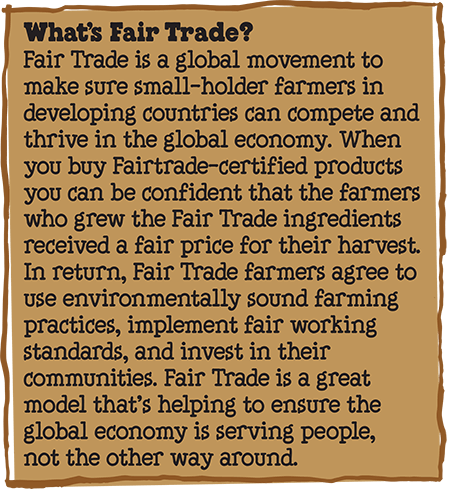2014 Social & Environmental
A LETTER FROM OUR CEO
I’m convinced that ten years from now, when we look back at this moment in time, we will realize what a critical inflection point we were at in 2014 and 2015. We are part of a world that is facing critical challenges at many levels: the changing climate, social unrest, the uncertain global economy, ineffective government and partisan politics. We’ve seen people take to the streets on climate change, social and racial justice, sometimes peacefully, sometimes not, which challenges us all to understand our individual and collective roles in creating positive change in our complex world. The team at Ben & Jerry’s understands this and we are all combining our best thinking and actions to bring about positive change as best we can throughout our business and beyond.
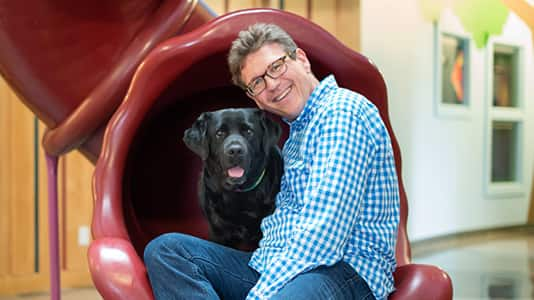
It’s a good thing we make ice cream, which, after all, can certainly lighten things up a bit. But, in all honesty, we source ingredients from various parts of the world such as sugar, cocoa, vanilla, coffee and banana where small-holder producers and the communities they live in will suffer more from the effects of climate change than communities in the developed global north. And we have a business model built on a concept of linked prosperity, where we strive to be certain that all of the stakeholders in our value chain are treated equitably and have the opportunity to build stronger, sustainable communities.
With that in mind, 2014 was a year in which we finished out some long-term priorities and reset the bar for the next five years, 2015-2020. We made a bold and ambitious commitment to reduce our carbon footprint per the experts’ 2050 global targets starting in 2015. We looked inward to better understand how we can recognize our own implicit biases in terms of race, class and faith and turn those understandings into a path towards social equity inside and outside of the company. As we now face so many fundamental challenges as a global society ranging from potentially catastrophic climate change to increasing inequality and intolerance our 5-year plan has to be even more ambitious in terms of social impact and we must approach our work with increasing urgency.
Looking back on 2014, let’s start with the good stuff:
- In 2014 we completed our global conversion to be fully Fairtrade-certified.
- We also completed in 2014 our conversion to using only non-GMO ingredients by origin.
- We continue to support a consumer’s right to know through mandatory labeling of GMO ingredients in consumer products.
- We’ve mapped our Fairtrade supply chain and have identified new ways we can invest in strengthening the Fairtrade model and improve small-holder livelihoods within our Fairtrade supply chain through our Producer Development Initiative.
- We’ve completed the full global harmonization of our Caring Dairy program and have started the process of rewriting its standards of sustainability so that we have a stronger program starting in 2016.
- We’ve taken it upon ourselves to understand our own carbon footprint through a lifecycle analysis of our products and we have started to design and implement a carbon reduction program to meet the targets that global experts say we need to meet by 2050.
- We continued to grow our Join Our Core program that celebrates and supports the new social entrepreneurs that are creating positive change in the world.
- We continued to support marriage equality around the world because it’s a human right to love whom you love and share in the social benefits of that institution
Now, the harder stuff:
- Regarding climate change: In working on a carbon reduction program, we realize that most of our carbon footprint is in our ingredients and agricultural supply chain, mostly specifically dairy. It will require an ambitious multiple stakeholder program to achieve the results we must achieve.
- Regarding Social Equity: We’ve turned our attention to trying to gain a better understanding of the complex and tenuous issues regarding social inequities as they relate to our business, our company culture and the communities we do business in, so that we can come up with a plan that results in a more socially equitable company.
In the end, our goal is to make the best ice cream in the world in the best possible way. I am immensely proud and confident that the Ben & Jerry’s team, around the world, will deliver on the ambitious plans we have ahead of us.
I hope you will take the time to dig in deeper to our 2014 SEAR and share any thoughts you might have with us that can help us become a better company.
Enjoy!
Jostein Solheim
CEO
HIGHLIGHTS IN 2014
Our Three-Part Mission Statement is at Our Core.
Ben & Jerry’s operates on a three-part mission that aims to create prosperity for everyone that’s connected to our business: suppliers, employees, farmers, franchisees, customers, and neighbors alike.
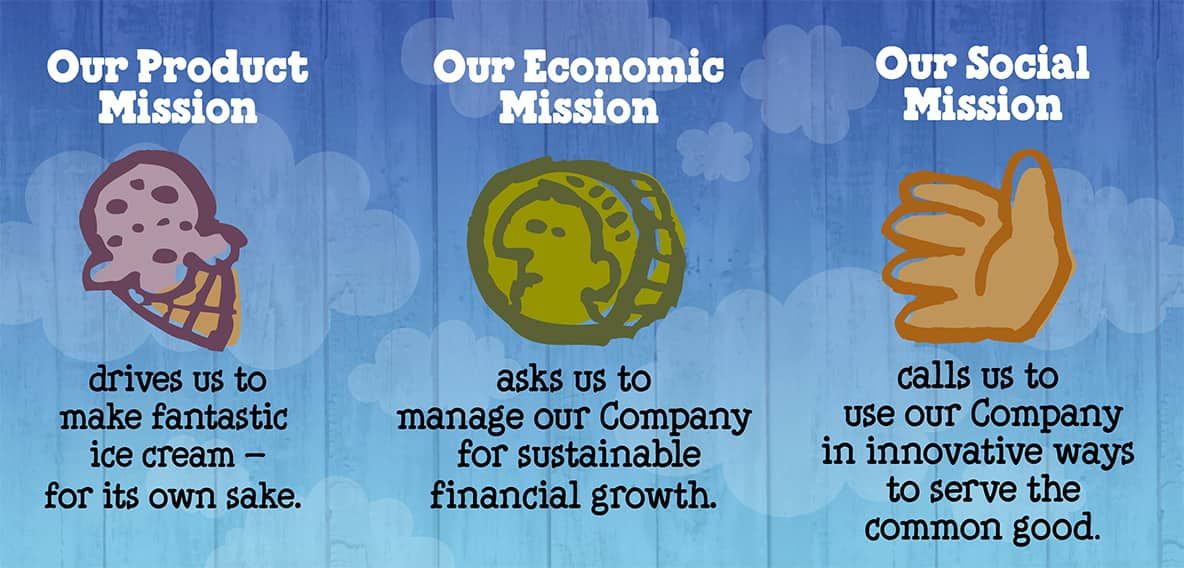
You can read the whole Ben & Jerry’s Mission Statement at www.benjerry.com/values.
Major Areas of Focus in 2014
A Sustainable Model of Linked Prosperity
 In 1988 we wrote it down. We were celebrating our 10th Anniversary in 1988 and realized that we needed to write down our belief in what business could be in the world, a positive force for change. That vision starts in the preamble of our three-part Mission Statement, that we are, “dedicated to a sustainable corporate concept of linked prosperity.” We’ve been working on it ever since. The idea is as simple as it is radical: as the company prospers, all those touched by the company must also prosper, including employees, suppliers, customers, and communities. A simple idea, but it takes a lot of work by a lot of people to make it happen.
In 1988 we wrote it down. We were celebrating our 10th Anniversary in 1988 and realized that we needed to write down our belief in what business could be in the world, a positive force for change. That vision starts in the preamble of our three-part Mission Statement, that we are, “dedicated to a sustainable corporate concept of linked prosperity.” We’ve been working on it ever since. The idea is as simple as it is radical: as the company prospers, all those touched by the company must also prosper, including employees, suppliers, customers, and communities. A simple idea, but it takes a lot of work by a lot of people to make it happen.
You could think of linked prosperity when considering how it benefits people through some of our more well known examples: our livable wage policy; ongoing support for family dairy farms, supporting small-holder producers by purchasing Fairtrade-certified ingredients and values-led sourcing partnerships such as with the Greyston Bakery in Yonkers, NY,  where they hire people with barriers to employment and empower them with skills training, a renewed sense of dignity and a paycheck at the end of the week. Or you could think of linked prosperity as benefitting the planet we share by supporting sustainable forms of agriculture. No matter how you think about it, it’s all linked.
where they hire people with barriers to employment and empower them with skills training, a renewed sense of dignity and a paycheck at the end of the week. Or you could think of linked prosperity as benefitting the planet we share by supporting sustainable forms of agriculture. No matter how you think about it, it’s all linked.
Throughout 2014 we continued to explore what a sustainable corporate concept of linked prosperity means today, in all its forms. But we are not just exploring a theory; we are finding practical ways to implement business decisions that manifest our best aspirations. Inside and outside of Ben & Jerry’s, we challenge ourselves to keep developing and implementing new ways that linked prosperity can, well, prosper by the way we choose to do business.
In 2014 we went through a comprehensive process of mapping out our five year vision for what we want to accomplish, which sets a direction that carries us well beyond the next five years.  We came to the understanding that we need to deeply focus Ben & Jerry’s on two overarching priorities: Climate Justice and Social Equity. The two intersect in profound ways. The work that we do as an agriculturally-based business, sourcing ingredients from the global north and south, selling ice cream around the world, compels us to stand on the two platforms of Climate Justice and Social Equity and deliver some significant results. That sets the table for 2015 – 2020 and, quite frankly, well beyond.
We came to the understanding that we need to deeply focus Ben & Jerry’s on two overarching priorities: Climate Justice and Social Equity. The two intersect in profound ways. The work that we do as an agriculturally-based business, sourcing ingredients from the global north and south, selling ice cream around the world, compels us to stand on the two platforms of Climate Justice and Social Equity and deliver some significant results. That sets the table for 2015 – 2020 and, quite frankly, well beyond.
Values Led Sourcing
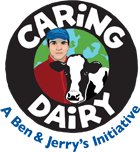 CARING DAIRY™.
CARING DAIRY™.
We’ve been working with dairy farmers in Vermont and the Netherlands for many years to help them push towards the leading edge of sustainable dairy practices. Now in its fourth year globally, our Caring Dairy™ program offers our farmer partners a practical framework for understanding, evaluating, and improving the sustainability of their dairy operations. The Caring Dairy™ Program is based upon an easy-to-use web based self-assessment tool, which enables farmers to evaluate their farm against a comprehensive set of economic, social and environmental criteria – or “sustainability indicators” – for farming. Leveraging the results of the self-assessment, we then help each farmer develop a unique action plan to improve his or her practices in the identified areas. In exchange for participating, Caring Dairy™ farmers get a little extra for their effort.
In 2014, the U.S. Caring Dairy™ program included 85 farms, including five new farms outside of Vermont that supply our western US production line. In The Netherlands, 340 Dutch farms participated in the program with 160 of those Dutch farms representing the dairy volume Ben & Jerry’s needs. These farms alone produce more than enough of the equivalent global dairy volume that we need to make our ice cream around the world!
Learn more about Caring Dairy™.
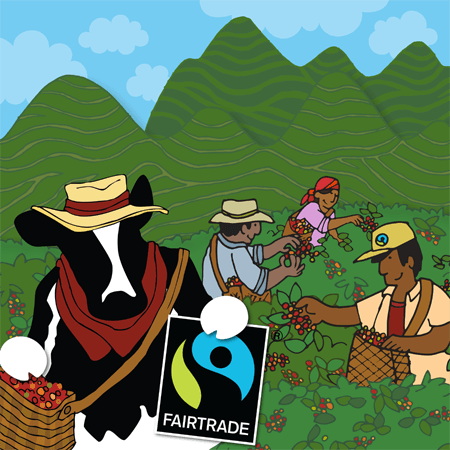
FAIRTRADE-CERTIFIED CONVERSION.
Although it took us nearly a year longer than we had anticipated, by the end of 2014, all of our products around the globe (with the exception of our ice cream bars, which, due to low production volume, we have not sought certification) were fully Fairtrade certified. To be clear, this means that all of our products (except our bars) meet the specifications required by Fairtrade International to carry the Fairtrade Certified seal. This does not mean that every ingredient (there are about 140!) in our products is sourced from Fairtrade producers. While all of our key commodities, which make up the bulk of our product, are traded in compliance with Fairtrade standards, there are still a few ingredients, such as certain spices, nuts and fruits, that we are unable to source from Fairtrade farms either because they are not available or don’t meet our specifications. (And, we should note, dairy does not fall under the Fairtrade program.)
In light of those ingredients we cannot source Fairtrade, we created the Producer Development Initiative (PDI) with our partner, Fairtrade International. The PDI intends to build and strengthen the supply chain for Fairtrade producers. In 2014 we continued to develop the PDI to help Fairtrade producers truly realize sustainable livelihoods.
Learn more about our commitment to Fairtrade.
NON-GMO CONVERSION.
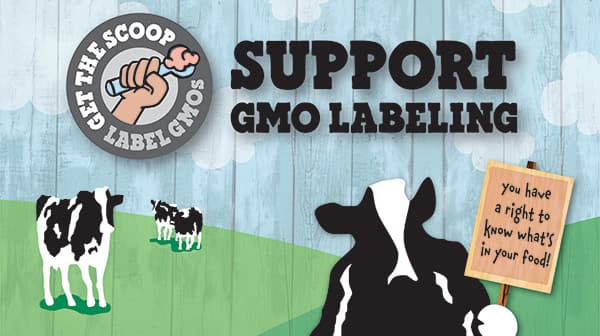
In 2012 we pledged to transition our North American sourcing to only non-GMO ingredients, by seed source, for all of our products and set out to do it before the end of 2013. We missed our original deadline, but by year-end 2014 all of the ingredients we were buying in North America were non-GMO by the original seed source. Since we’ve been sourcing non-GMO ingredients by seed source in Europe and Asia for several years, we are proud to report that now all of the ingredients we purchase are non-GMO by seed source (except for our ice cream bars, which, due to low production volume, were not part of the conversion). Learn more about our conversion to non-GMO sourcing and our position on GMO labeling.
Social & Economic Justice
JOIN OUR CORE.
In partnership with our friends at Ashoka we sponsored the Join Our Core competition to find and help support the best young social entrepreneurs across Europe and Asia. The competition is the perfect way for Ben & Jerry’s to support young entrepreneurs who share our vision of linked prosperity. 2014 marked the third anniversary of the European competition and the inaugural year for Singapore and Japan. One winner from each of the participating 11 countries was then chosen. Each winner received a €10,000 cash prize, a business mentoring program from the social enterprise gurus at Ashoka, and a trip to Ben & Jerry’s headquarters in Vermont. The winners will also have their business logos featured on an exclusive Ben & Jerry’s flavor in 2015.
Learn more about the Join Our Core social entrepreneurs.
Measuring What Matters: Fine Tuning Our Metrics Model
Ben & Jerry’s has been issuing public reports on our social and environmental activities since our 1988 annual report. 2014 is the fifth year we are using our Quality of Results (QoR) framework to measure our performance in key areas.
The primary purpose of the QoR is to give Ben & Jerry’s management, Ben & Jerry’s Board of Directors, Unilever management and you a clear scorecard by which to evaluate the Company’s social and environmental performance.
The QoR measures specific goals for our social and environmental performance within 14 priorities of our business. For our 2014 report, we engaged Moss Adams LLP, an independent accounting firm, to review specific QoR indicators that Ben & Jerry’s set as priorities for the year.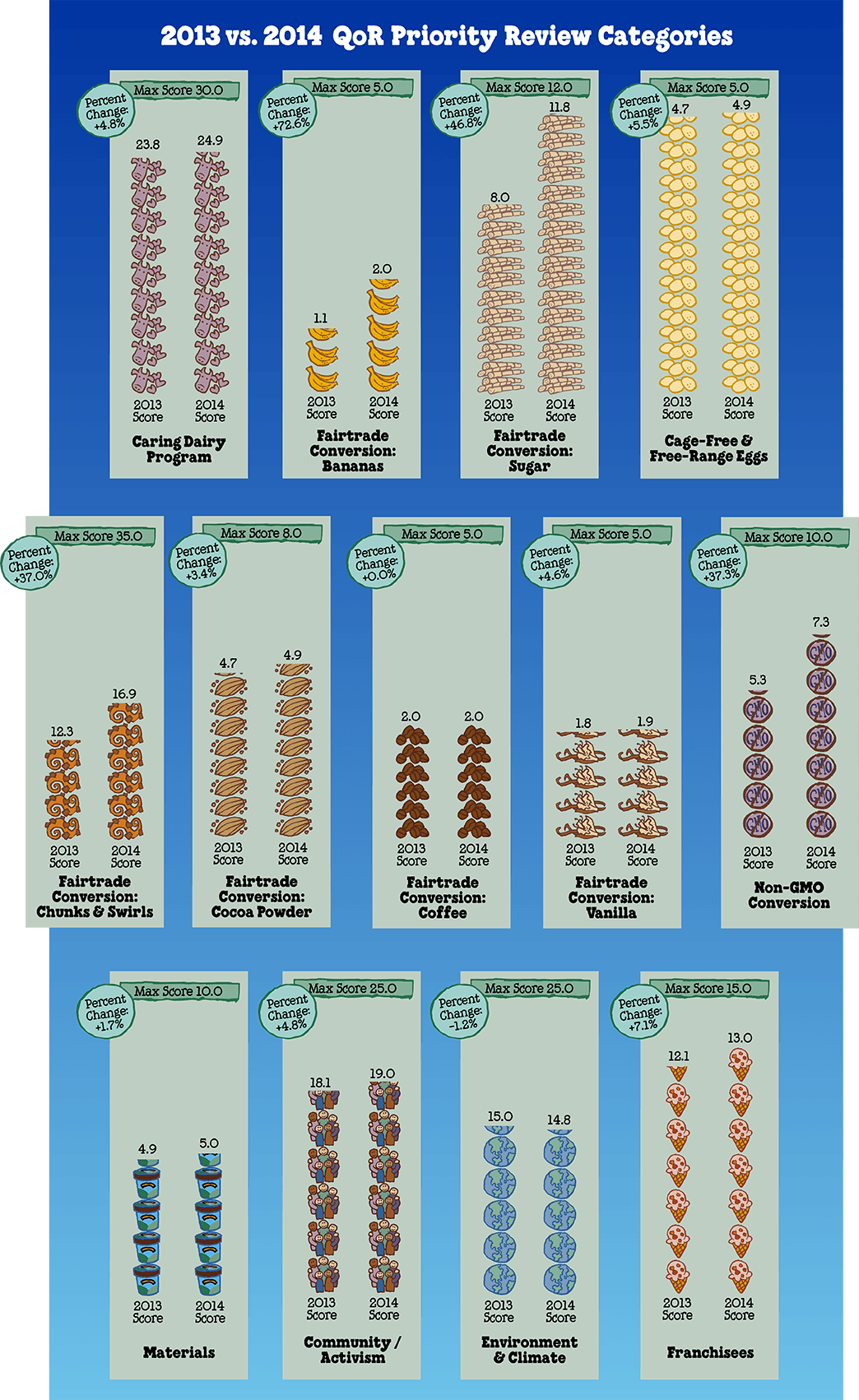 The specific scope of Moss Adams’ review primarily focuses on our Caring Dairy™ program, our Fairtrade conversion, and our non-GMO ingredient sourcing. You can read Moss Adams’ review here.
The specific scope of Moss Adams’ review primarily focuses on our Caring Dairy™ program, our Fairtrade conversion, and our non-GMO ingredient sourcing. You can read Moss Adams’ review here.
In 2015 we plan to test some adjustments to the QoR framework to better assess our impact on people and the planet, as well as our practices and progress. We plan to raise the bar for current QoR indicators, set annual targets for Social Mission initiatives and clarify indicators of success.
In 2015 we will continue to fine tune how we measure our performance and have plans to launch a new, more comprehensive score card in 2016.
We made some gains in 2014 over 2013 for our overall QoR numbers. We’re proud of that progress.
OUR COMPANY
How We Work
Ben & Jerry’s has been making ice cream since 1978 when grade school buddies Ben Cohen and Jerry Greenfield opened their first scoop shop in Burlington, Vermont. Though we’ve never strayed from the boys’ original dream — to create unique and euphoric ice cream flavors while making a positive impact along the way — we have grown and changed in all sorts of ways.
Ben & Jerry’s is owned by Unilever. As of 2013, our packaged ice cream and novelties, such as ice cream bars and sandwiches, are sold in 35 countries, primarily through packaged products in retail outlets. Ben & Jerry’s also sold products, in 2013, through scoop shops operating in 20 countries. Our products are produced in pints, quarts, 500 ml cups, 2.4 gallon, 9.08 liter and 4.5 liter tubs, single-serve cups and individual novelties; and these are distributed in supermarkets, grocery stores, convenience stores, scoop shops, restaurants and other venues. By the end of 2013, outside of North America, Ben & Jerry’s products were marketed and distributed by affiliated companies within Unilever, and third-party licensees in Israel, Hong Kong and Singapore.
Governance
Ben & Jerry’s global business is managed out of our Central Support office in South Burlington, Vermont. Ben & Jerry’s sits within Unilever’s Refreshments division, which is managed globally out of London and regionally from Unilever offices in Englewood Cliffs, New Jersey.
Ben & Jerry’s Board of Directors
 Our Chief Executive Officer, Jostein Solheim, receives direction, counsel and support from an independent Ben & Jerry’s Board of Directors, established at the time of the Unilever acquisition. The Board is responsible for Ben & Jerry’s Social Mission and the Essential Integrity of Ben & Jerry’s, which includes, among other things, product quality and standards. In this role, the Board advises and supports Ben & Jerry’s senior management in maintaining and strengthening the Company’s three-part Mission Statement and protecting Ben & Jerry’s brand equity. This Board, which meets in full on a quarterly basis, and conducts ongoing committee work throughout the year, includes several directors who were with Ben & Jerry’s prior to the acquisition by Unilever.
Our Chief Executive Officer, Jostein Solheim, receives direction, counsel and support from an independent Ben & Jerry’s Board of Directors, established at the time of the Unilever acquisition. The Board is responsible for Ben & Jerry’s Social Mission and the Essential Integrity of Ben & Jerry’s, which includes, among other things, product quality and standards. In this role, the Board advises and supports Ben & Jerry’s senior management in maintaining and strengthening the Company’s three-part Mission Statement and protecting Ben & Jerry’s brand equity. This Board, which meets in full on a quarterly basis, and conducts ongoing committee work throughout the year, includes several directors who were with Ben & Jerry’s prior to the acquisition by Unilever.
Our Mission

Ben & Jerry’s is founded on and dedicated to a sustainable corporate concept of linked prosperity. Our mission consists of three interrelated parts:
![]() Product Mission To make, distribute and sell the finest quality all natural ice cream and euphoric concoctions with a continued commitment to incorporating wholesome, natural ingredients and promoting business practices that respect the Earth and the Environment.
Product Mission To make, distribute and sell the finest quality all natural ice cream and euphoric concoctions with a continued commitment to incorporating wholesome, natural ingredients and promoting business practices that respect the Earth and the Environment.
![]() Economic Mission To operate the Company on a sustainable financial basis of profitable growth, increasing value for our stakeholders and expanding opportunities for development and career growth for our employees.
Economic Mission To operate the Company on a sustainable financial basis of profitable growth, increasing value for our stakeholders and expanding opportunities for development and career growth for our employees.
![]() Social Mission To operate the company in a way that actively recognizes the central role that business plays in society by initiating innovative ways to improve the quality of life locally, nationally and internationally.
Social Mission To operate the company in a way that actively recognizes the central role that business plays in society by initiating innovative ways to improve the quality of life locally, nationally and internationally.
Underlying the mission is the determination to seek new and creative ways of addressing all three parts, while holding a deep respect for individuals inside and outside the company and for the communities of which they are a part.
Leading with Progressive Values Across Our Business
We have a progressive, nonpartisan Social Mission that seeks to meet human needs and eliminate injustices in our local, national, and international communities by integrating these concerns into our day-to-day business activities.
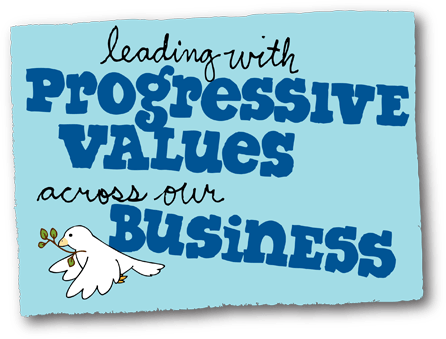
Our focus is on children and families, the environment and sustainable agriculture on family farms.
Capitalism and the wealth it produces do not create opportunity for everyone equally. We recognize that the gap between the rich and the poor is wider than at any time since the 1920s. We strive to create economic opportunities for those who have been denied them and to advance new models of economic justice that are sustainable and replicable.
By definition, the manufacturing of products creates waste. We strive to minimize our negative impact on the environment.
The growing of food is overly reliant on the use of toxic chemicals and other methods that are unsustainable. We support sustainable and safe methods of food production that reduce environmental degradation, maintain the productivity of the land over time, and support the economic viability of family farms and rural communities.
We seek and support nonviolent ways to achieve peace and justice. We believe government resources are more productively used in meeting human needs than in building and maintaining weapons systems.
We strive to show a deep respect for human beings inside and outside our company and for the communities in which they live.
Operations
Ben & Jerry’s ice cream for the North American market is made in our manufacturing plants in Waterbury and St. Albans, Vermont and in a Unilever facility in Henderson, Nevada. We also make it for the Canadian market in a Unilever facility in Simcoe, Ontario. Our U.S. frozen novelties, such as ice cream bars, are manufactured at a Unilever facility in Sikeston, Missouri. In 2014, we made Ben & Jerry’s ice cream for the European market at Unilever facilities in Hellendoorn, The Netherlands, and Caivano, Italy. Products for Asia and Australia were exported from our facilities in the U.S and the Netherlands.
VALUES-LED SOURCING (VLS)
Overview
Under the broadest lens, we work to make all of our sourcing decisions value-led decisions. From our sustainable dairy program, Caring Dairy™, to our Fairtrade-certified ingredients and non-GMO sourcing, to ingredients made for us by social enterprises, all of these decisions are based in our values.
There is a special category of VLS suppliers: social enterprises that work to create change within their communities. Often, when referring to a “VLS” supplier, people think about this category. And that’s what this section of the SEAR is focusing on. In order to make great ice cream and create positive social change, Ben & Jerry’s continues to search for ingredient suppliers all along the supply chain who are aligned with our Company’s mission and core values. These are suppliers who, through their business practices or through their products, are expanding economic opportunities for those not afforded them, or leading the way to more sustainable environmental or agricultural systems.
In 2012 we started the process of better defining what it means to be a Ben & Jerry’s VLS supplier. Late in 2013 it dawned on us that our friends at B Lab had developed a comprehensive measurement tool that aligned nicely with our own values and criteria called the B Impact Assessment tool. We figured there’s no sense in reinventing the wheel, so in 2014 we piloted using the B Impact Assessment tool with a handful of key suppliers. This new tool gave us a great benchmarking framework and helps us understand where we stand, and our suppliers, in comparison to other companies.
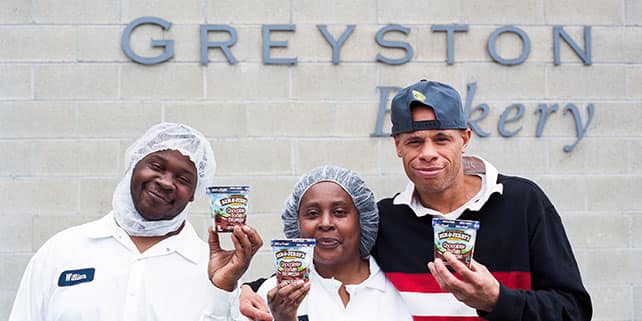 Overall, we see how the B Impact Assessment can help us improve our VLS practices and ultimately increase the number of suppliers that we are working with who share our goal to create social, economic and environmental benefits.
Overall, we see how the B Impact Assessment can help us improve our VLS practices and ultimately increase the number of suppliers that we are working with who share our goal to create social, economic and environmental benefits.
In 2014, considering the B Impact Assessment standards and other socially progressive attributes, we would designate one supplier, Greyston Baker, as a full-fledged VLS partner and a second supplier, Rhino Foods, as a VLS partner-in-development:
- The Greyston Bakery, in Yonkers, New York, has been supplying us with chocolate brownies for our Chocolate Fudge Brownie flavor for over 25 years. The bakery is owned by the Greyston Foundation, a nonprofit organization with a mission to support people with barriers to employment on the path to self-sufficiency. Greyston’s programs reach over 2,000 people a year through child care, housing, health care, and other services. Greyston is also a certified Benefit Corporation (B Corp), which means that Greyston satisfied rigorous criteria to earn B Corp status alongside a growing community of companies that include a social purpose alongside their product and economic missions.
- Rhino Foods is another longtime supplier that makes the gobs of cookie dough we use in our Chocolate Chip Cookie Dough ice cream. In 2013, Rhino became a certified B Corp, which is quite an accomplishment! Rhino has, over time, developed a variety of programs that supports its employees and the surrounding community. Rhino employs dozens of people who have come to the U.S. as refugees from around the world. Through a unique variety of support programs, Rhino helps these and all of its employees to earn a living, save money, develop a credit history, and make a new life for themselves and their families.
VLS Ingredients
In 2014 we continued to make slow but steady progress on our commitment to Values-Led Sourcing. Using B Lab’s B Impact Assessment, we have more clearly defined standards and a stronger framework for evaluating suppliers. Although the overall percentage of VLS sourced products decreased ever so slightly from 2013 to 2014, the decrease is a reflection of the increased volume of our new core products, which do not include VLS sourced ingredients from social enterprises.
- Globally, about 26% of chunks and swirls were purchased from VLS suppliers, down from 28% in 2013.
- 21.2% of the chunks and swirls we purchased in North American were from Values Led Suppliers, down from 22% from 2013.
- In Europe 36.5% of chunks and swirls were purchased from VLS suppliers down from 37% in 2013.
Code of Business Principles
All of the suppliers for Ben & Jerry’s ice cream are expected to follow practices consistent with the Code of Business Principles of our parent company, Unilever. This code includes: continuous improvement in managing environmental impacts, safe and healthy standards for workers, and a firm commitment to human rights, among other things. Unilever is also a signatory to the U.N. Secretary General’s Global Compact of 1999, which commits the company to support and respect human rights within our sphere of influence.
DAIRY
Setting Global Standards for Sustainable Dairy Practices
We’ve been working with dairy farmers in Vermont and the Netherlands for many years to help them push towards the leading edge of sustainable dairy practices. Now in its fourth year globally, our Caring Dairy™ program offers our farmer partners a practical framework for understanding, evaluating, and improving the sustainability of their dairy operations.  The Caring Dairy™ Program is based upon an easy-to-use web based self-assessment tool, which enables farmers to evaluate their farm against a comprehensive set of economic, social and environmental criteria – or “sustainability indicators” – for farming. Leveraging the results of the self-assessment, we then help each farmer develop a unique action plan to improve his or her practices in the identified areas. In exchange for participating, Caring Dairy™ farmers get a little extra for their effort.
The Caring Dairy™ Program is based upon an easy-to-use web based self-assessment tool, which enables farmers to evaluate their farm against a comprehensive set of economic, social and environmental criteria – or “sustainability indicators” – for farming. Leveraging the results of the self-assessment, we then help each farmer develop a unique action plan to improve his or her practices in the identified areas. In exchange for participating, Caring Dairy™ farmers get a little extra for their effort.
In 2014, the US Caring Dairy™ program included 85 farms, adding 5 new farms in Utah that supply our Henderson, NV plant. In the Netherlands, we saw a significant increase in the number of participating farms, 340 in 2014, up from 255 in 2013, 160 of which cover the volume necessary for Ben & Jerry’s. This leaves us just two current suppliers, serving a small volume of Ben & Jerry’s products produced at factories in Ontario, Canada and Sikeston, Missouri to bring into the program. From a volume perspective, Caring Dairy™ covers our global production needs but our intention is to have all dairy suppliers that Ben & Jerry’s sources from operating under the Caring Dairy™ program in the not-too-distant future. However, under a mass-balancing approach, Caring Dairy™ farms produce the dairy volume Ben & Jerry’s needs for global production.
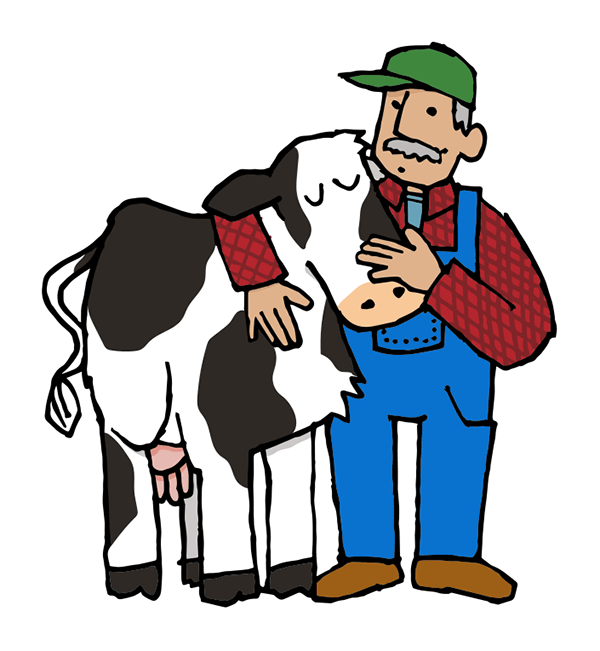 This year’s data showed that participating farmers continue to improve their overall on-farm performance, as the scores have trended upwards year over year. From the data collected in 2014, Social and Human Capital and Biodiversity were the lowest scoring sections. Social and Human Capital was one of the two lowest scoring sections in 2012 and 2013, but Biodiversity replaced Pest Management in 2014. The highest scoring sections remained Animal Husbandry, Farm Financials and Impact on Local Economy, as they were in 2012 and 2013. Continuing the trend of increasing scores year over year, the average indicator scores by year were up in 8 of the sections, stayed the same in one section, and dropped slightly in two sections.
This year’s data showed that participating farmers continue to improve their overall on-farm performance, as the scores have trended upwards year over year. From the data collected in 2014, Social and Human Capital and Biodiversity were the lowest scoring sections. Social and Human Capital was one of the two lowest scoring sections in 2012 and 2013, but Biodiversity replaced Pest Management in 2014. The highest scoring sections remained Animal Husbandry, Farm Financials and Impact on Local Economy, as they were in 2012 and 2013. Continuing the trend of increasing scores year over year, the average indicator scores by year were up in 8 of the sections, stayed the same in one section, and dropped slightly in two sections.
The longer farmers participated in Caring Dairy™, the higher they scored.
Having multi-year data has helped us to spot trends and enhance the program, which means better results for farmers, the planet and happier cows too.
Learn more about Caring Dairy™.
NON-GMO
What are GMOs?
Genetically modified organisms, or GMOs, are organisms that have had their genetic makeup (DNA) altered through genetic engineering in a way that does not occur in nature or through traditional cross-breeding methods. GMOs are found in key commodity crops grown in the United States, such as corn, soy and sugar beet. According to the Non-GMO Project, a non-profit advocate for non-GMO food and products, as much as 80% of the conventionally processed food products on grocery store shelves in the US contain one or more genetically engineered ingredients, it's likely that the majority of us eat foods that contain GMOs on a regular basis.
Where we stand on GMOs
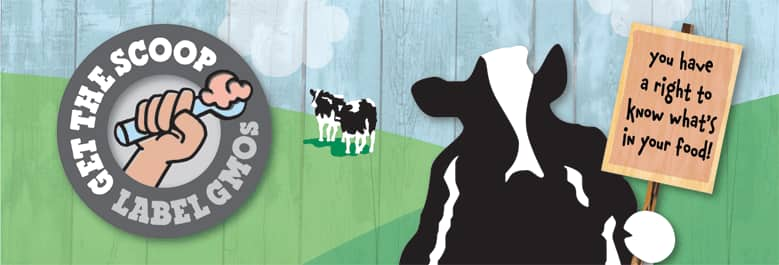 Ben & Jerry’s supports sourcing non-GMO ingredients by origin. Non-GMO by origin refers to non-GMO according to the original seed source. That means that the seeds for ingredients that might use corn or soy, for example, are non-GMO. These ingredients would show up in our chunks and swirls as corn syrup or soy lecithin. Just so you know, our ice cream base mix is already totally non-GMO by origin because the ingredients we use are not at risk for GMO sources. However, the fresh rBGH free Vermont milk and cream that our family farmers supply to us is not organic. This means that it is almost certain that some portion of the cows’ feed contains GMO ingredients, such as corn and soy. But because neither the cow nor the milk and cream they provide us are genetically modified, our products would not be required to be labeled as GMO under the legislation currently being considered in several states. However, we understand the complex issues around GMO animal feed and we are looking into how we can best develop cost effective non-GMO alternatives that could be strong options for the family farms we source from and whom we’ve supported since our earliest days in business.
Ben & Jerry’s supports sourcing non-GMO ingredients by origin. Non-GMO by origin refers to non-GMO according to the original seed source. That means that the seeds for ingredients that might use corn or soy, for example, are non-GMO. These ingredients would show up in our chunks and swirls as corn syrup or soy lecithin. Just so you know, our ice cream base mix is already totally non-GMO by origin because the ingredients we use are not at risk for GMO sources. However, the fresh rBGH free Vermont milk and cream that our family farmers supply to us is not organic. This means that it is almost certain that some portion of the cows’ feed contains GMO ingredients, such as corn and soy. But because neither the cow nor the milk and cream they provide us are genetically modified, our products would not be required to be labeled as GMO under the legislation currently being considered in several states. However, we understand the complex issues around GMO animal feed and we are looking into how we can best develop cost effective non-GMO alternatives that could be strong options for the family farms we source from and whom we’ve supported since our earliest days in business.
Ben & Jerry’s is engaged at several levels in supporting a robust non-GMO food supply. At the heart of our actions is a long-term vision of systemic change that creates more options for non-GMO foods and ingredients.
Our work in this area is focused on:
- Converting our own products to non-GMO ingredients by origin
- Supporting a consumer’s right to know through mandatory product labeling
- Working to rebuild a robust system of non-GMO agriculture
Going Non-GMO
OUR PRODUCTS & SUPPLY CHAIN
In 2012 we began the complex process of converting all of our products to non-GMO ingredients by seed source. We made steady progress in 2013 and our work in 2014 focused on completing the conversion for our toughest to source ingredients, the chunks and swirls. Over the course of 2014, 94.96% of our ingredients, by volume, were non-GMO by the original seed source for that ingredient. Although it took us about a year longer than we originally planned, today, all of our ingredients by seed source including the chunks and swirls are from non-GMO sources. We will continue to verify our ingredients through supplier documentation, which will be reviewed by an independent third-party firm.
In Europe and Asia, Ben & Jerry’s follows local requirements for non-GMO ingredients.
ADVOCATING FOR CONSUMERS’ RIGHT TO KNOW ABOUT GMO’s
In 2014, we got to work in our home state to support mandatory GMO labeling. After a hard fought battle, Vermont became the first and only state to require a “no strings attached” GMO labeling law.  This means that regardless of action taken in other states,Vermont will be catching up with the 64 countries that require GMO foods to be labeled.
This means that regardless of action taken in other states,Vermont will be catching up with the 64 countries that require GMO foods to be labeled.
Soon after Vermont’s historic bill was signed into law, several large organizations representing the biotechnology and food industry filed a law suit against the State of Vermont for protecting its citizens’ right to know about GMOs in their food. In response, the State of Vermont set up a crowd-funded legal fund to defend its historic labeling law. Appropriately the fund is called, The Vermont Food Fight Fund. To help support the fund, we temporarily renamed one of the most iconic flavors, Chocolate Fudge Brownie, to Food Fight Fudge Brownie and pledged $1 from each sale to the fund.
We also focused our education and advocacy efforts in Oregon and launched LABELIZE IT! a campaign focused on getting Oregonians to take action and support Measure 92, a state-wide ballot initiative calling for mandated labeling. A win in Oregon could have been the spark to ignite a national movement, so we fired up our social media campaign and hit the streets. We turned up at music festivals like Bonnaroo, hit the road in Portland, Eugene and Bend in our decked-out LABELIZE IT! scoop truck, and doled out free ice cream and information about GMO labeling. Unfortunately, the measure was narrowly defeated.
Our end goal is a national labeling standard, but since it’s pretty clear that Congress won’t act anytime soon we will continue to support state’s efforts to pass laws like ours in Vermont. 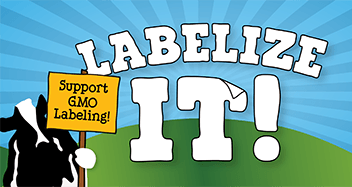 Our theory is that once states start getting involved, this will up the pressure on congress to pass a national law, which would be simpler for consumers and easier for food producers to comply with. This is an issue we won’t give up on and plan to continue working on the state and national levels and with our partners at Just Label It!, because we believe consumers have the right to know what’s in their food.
Our theory is that once states start getting involved, this will up the pressure on congress to pass a national law, which would be simpler for consumers and easier for food producers to comply with. This is an issue we won’t give up on and plan to continue working on the state and national levels and with our partners at Just Label It!, because we believe consumers have the right to know what’s in their food.
Learn more about why we support mandatory GMO labeling, and a consumer's right to know.
Working for Systematic Change
REBUILDING THE NON-GMO SUPPLY CHAIN
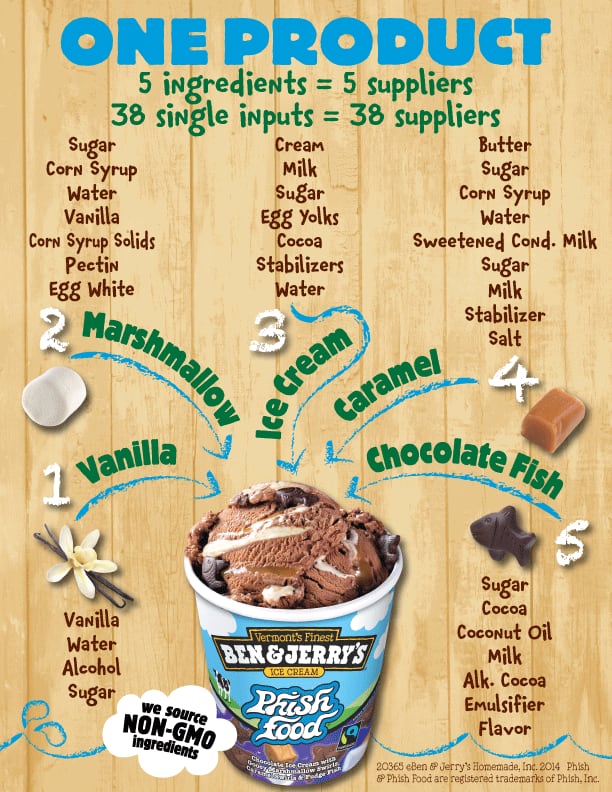 In the United States a majority of commodities produced are GMO. In fact, according to USDA, between 88%-95% of all corn, soy, canola, and sugar beet in the US are genetically modified, depending on the commodity. We’d like to turn the tide away from the dominance of GMOs to protect consumers’ choice of food ingredients and products. We want to create sustainable, cost-effective conditions for farmers to succeed in growing non-GMO corn, soy, canola, sugar beet and other commodities. This work, in turn, will make it possible for the family dairy farmers in our supply chain to find competitively priced non-GMO feed for their cows.
In the United States a majority of commodities produced are GMO. In fact, according to USDA, between 88%-95% of all corn, soy, canola, and sugar beet in the US are genetically modified, depending on the commodity. We’d like to turn the tide away from the dominance of GMOs to protect consumers’ choice of food ingredients and products. We want to create sustainable, cost-effective conditions for farmers to succeed in growing non-GMO corn, soy, canola, sugar beet and other commodities. This work, in turn, will make it possible for the family dairy farmers in our supply chain to find competitively priced non-GMO feed for their cows.
In 2014, we continued our work on developing a path to produce more non-GMO options within agriculture. We have been working with multiple stakeholders throughout the value chain to envision that path and then build it. We believe that collaborative approaches are necessary to create a more diverse and sustainable food system and to create better long-term outcomes for everyone - farmers, consumers, and the environment.
rBGH
Since 1989, Ben & Jerry’s has opposed the use of recombinant bovine growth hormone (rBGH), a genetically engineered hormone given to cows to increase their milk production. We think rBGH is a step in the wrong direction. In the U.S., we require our dairy farmers to pledge that they don’t treat their cows with rBGH. The U.S. Food and Drug Administration has stated that there is no significant difference between milk from rBGH-treated and untreated cows. But in Canada and most European countries, rBGH has never been able to win government approval so, in those countries, it’s one less thing we have to worry about. Even in the U.S., rBGH use has declined in recent years – and we look forward to the day when it is no longer used in the dairy industry.
Although it’s been decades since we first took a stand on rBGH, we stand vigilant to defend the consumer's right to know and to ensure a reliable supply of dairy that comes from cows that are not treated with rBGH.
FAIRTRADE
Fair Trade Conversion.
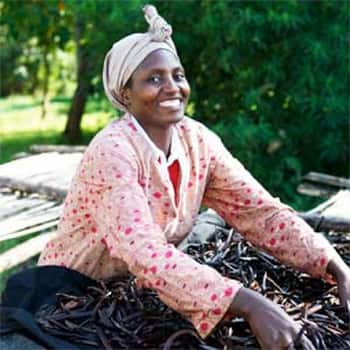 When we first set the goal to convert our products to Fairtrade-certified in 2010, we knew the process would be complex. After all told, our global conversion to Fairtrade-certified includes about 140 ingredients in 200 different products. The logistics behind that scale of conversion can slow down any ambition and perhaps we were a tad overly ambitious at the start. Early on in the conversion process we discovered that it would be logistically impossible to implement the methodically phased-in conversion process that we had originally committed to. Plus, our Fairtrade conversion schedule was affected by our big plans for our non-GMO conversion in North America. Working with our partners at Fairtrade International, we grew more realistic and recalibrated our original deadline for conversion. Although it took us nearly a year longer than we had anticipated, by the end of 2014, all of our products around the globe (with the exception of our ice cream bars) were fully Fairtrade certified.*1
When we first set the goal to convert our products to Fairtrade-certified in 2010, we knew the process would be complex. After all told, our global conversion to Fairtrade-certified includes about 140 ingredients in 200 different products. The logistics behind that scale of conversion can slow down any ambition and perhaps we were a tad overly ambitious at the start. Early on in the conversion process we discovered that it would be logistically impossible to implement the methodically phased-in conversion process that we had originally committed to. Plus, our Fairtrade conversion schedule was affected by our big plans for our non-GMO conversion in North America. Working with our partners at Fairtrade International, we grew more realistic and recalibrated our original deadline for conversion. Although it took us nearly a year longer than we had anticipated, by the end of 2014, all of our products around the globe (with the exception of our ice cream bars) were fully Fairtrade certified.*1
Fairtrade Producer Development Initiative
 In 2013, we created the Producer Development Initiative (PDI) in partnership with Fairtrade International to strengthen the overall Fairtrade system and to increase the availability of tougher-to-source Fairtrade ingredients. The goal of the PDI is to help small-holder producers who are already Fairtrade certified or who aspire to Fairtrade certification to become better business partners and to achieve a sustainable living to support the economic, social, and environmental health of their communities. The PDI will achieve this objective by innovating and investing in projects that help small-holder producers build capacity, improve quality and gain expanded market access for their products, so that they can experience more success in global markets and supply chains.
In 2013, we created the Producer Development Initiative (PDI) in partnership with Fairtrade International to strengthen the overall Fairtrade system and to increase the availability of tougher-to-source Fairtrade ingredients. The goal of the PDI is to help small-holder producers who are already Fairtrade certified or who aspire to Fairtrade certification to become better business partners and to achieve a sustainable living to support the economic, social, and environmental health of their communities. The PDI will achieve this objective by innovating and investing in projects that help small-holder producers build capacity, improve quality and gain expanded market access for their products, so that they can experience more success in global markets and supply chains.
We spent the bulk of 2014 working with our partners to map our supply chain and identify projects that will strengthen the Fairtrade supply chain, which we will implement in 2015. Although we have a lot of work to do to achieve systemic change, we have a plan in place that will help to strengthen the Fairtrade model and contribute to a more sustainable agricultural system that is better for people and the planet.
Learn more about Fairtrade in the U.S. and around the world.
Building the Fair Trade Movement
The global Fair Trade movement will only succeed in its mission to create social, economic, and environmental benefits in developing countries if ice cream-lovers and coffee-drinkers and morning banana-eaters understand what Fair Trade is – and seek out products with the Fairtrade-certified logo. That’s why we think teaching people about Fair Trade is just as important as sourcing Fairtrade-certified ingredients for our products. We want to work at both ends of the Fair Trade system: educating consumers to create more demand, and working with Fair Trade stakeholders within the system to improve supply and livelihoods for Fair Trade producers.
*1 - This does not mean that every ingredient in our products is sourced from Fairtrade suppliers. There are a few ingredients such as certain fruits, nuts and spices that we are currently unable to source from Fairtrade suppliers. In those cases, Fairtrade International has provided us derogations (approved waivers) to show that despite our efforts to source these products from Fairtrade suppliers, we were unable to, either because they did not meet our quality specifications or they were just not commercially available to us. Our products have earned the Fairtrade seal because they meet and in many cases actually exceed the requirements of the Fairtrade Certification by Fairtrade International.
In 2014 we kept up efforts to educate consumers about the value of Fairtrade-certified products and strengthen the Fair Trade system. Here’s how:
- We continued to engage with our Fairtrade Producer Development Initiative (PDI) partners and gained traction as we kicked off the PDI Steering Committee.
- We prioritized strategy development for 3 of our key commodities: cocoa, coffee and vanilla, and created tools to better assess our effectiveness in achieving our Fairtrade goals.
- We initiated dialogue with several key suppliers to strategize shifting to Fairtrade and establishing multi-year relationships with cooperatives to help build a reliable supply chain and a healthy Fairtrade ecosystem.
- We became an associate member of the Domestic Fair Trade Association
- We continued to contribute proceeds from our flavor, “Late Night Snack” to support Fair Trade Universities in the US. (Although, sadly, due to Jimmy Fallon’s new job as the Tonight Show’s host, “Late Night Snack” is discontinued, which means this royalty will sunset as this flavor sells out.)
- We participated in events for World Fair Trade Day, Fairtrade Fortnight in the UK, and Fair Trade Month in the U.S. to spread the word!
- And several of Ben & Jerry’s scoop shops have supported their local communities’ efforts to become Fair Trade towns.
Converting Our 5 Key Commodities to Fairtrade-Certified
PRODUCER DEVELOPMENT INITIATIVE OBJECTIVE
The objective of the Fairtrade Producer Development Initiative (PDI) is to help small-holder producers who are already Fairtrade certified or who aspire to Fairtrade certification achieve a sustainable living in agriculture while supporting the economic, social, and environmental health of their communities. The PDI will achieve this objective by funding projects that assist producer groups in building capacity, improving quality and gaining expanded market access for their products so that they can experience more success in global markets and supply chains. Where possible, projects will also be designed to support the longer-term sustainability of producer enterprises through:
- Climate change adaptation and mitigation
- Improving producer organizational infrastructure
- Improving access to short- and long-term financing
- Crop and income diversification
- Developing value-added processing capacity at origin
- Achieving Fairtrade certification
By the end of 2014, all of our five key commodities, in our base mixes and our chunks and swirls, were Fairtrade-certified. That means we reached our goal to have all of our products, globally, qualify for the Fairtrade-certified seal (with the exception of Ben & Jerry’s bars). In the progress report that follows, the percentages reflect Fairtrade volumes purchased over the span of 2014 as we moved to completing the conversion by the end of the year. In 2015 these volume percentages should reflect the full conversion.
PDI SCOPE
The PDI will aim to implement projects that focus on producer groups growing and marketing Fairtrade certified agricultural products that are used, or could be used, in Ben & Jerry’s supply chain. We want to focus our resources within the supply chain where we source the highest volume of Fairtrade-certified ingredients. The most significant ingredients, the ones that make up the bulk of our Fairtrade sourcing, include:
- SUGAR
- COCOA
- COFFEE
- VANILLA
- BANANA
SUGAR: Our goal is to make sure that all of the sugar we purchase is traded in compliance with Fairtrade standards.
In Europe, 100% of the sugar used in base mixes of all Ben & Jerry’s products has been traded in compliance with Fairtrade standards since 2013.
In North America, we were a year later than we wanted to be but achieved a full conversion by the end of 2014.
GOAL: Our revised goal was to achieve full conversion to Fairtrade sugar in our base-mix, globally, by end of 2014.
PROGRESS: In 2014:
- Globally, 98.4% of the sugar used in Ben & Jerry’s base mixes was traded in compliance with Fairtrade standards; up from just over 67% in 2013.
- In North America, over 97.8% of sugar used in our base mix was traded in compliance with Fairtrade standards, up from 52% in 2013.
- In Europe, 100% of the sugar we added to our base mixes was traded in compliance with Fairtrade standards.
COCOA: For many die-hard Ben & Jerry’s fans, there wouldn’t be much point to eating ice cream at all if it didn’t have chocolate in it somewhere. So it’s no surprise that nearly three-quarters of our flavors have chocolate or cocoa in them, in the form of cocoa powder, chocolate chunks, milk chocolate Peace signs, fudge swirls, and various other gobs, chips, and flakes.
Taken together, these ingredients use a significant volume of cocoa powder or cocoa butter. We believe that by transitioning to cocoa-based ingredients that are traded in compliance with Fairtrade standards, we can have a significant impact on improving the livelihoods of our cocoa farmers.
When we began the conversion process, we hoped to be fully converted to Fairtrade cocoa by the end of 2013. At the end of 2014 we came close to achieving that goal.
With our Fairtrade Producer Development Initiative partners, we are working to pursue more direct relationships with cocoa cooperatives in Cote D’Ivoire. In 2015 we hope to engage in multi-year partnerships with a few select cooperatives and achieve our goal of converting 100% of the cocoa used in Ben & Jerry’s base mixes (globally), to cocoa that is traded in compliance with Fairtrade standards.
GOAL: Our revised goal was to achieve full conversion to Fairtrade cocoa in our base-mix, globally, by end of 2014.
PROGRESS: In 2014:
- Globally, 97.1% of all the cocoa in our base mix was traded in compliance with Fairtrade standards, up from almost 94% in 2013.
- In North America, the purchase of cocoa powder that was traded in compliance with Fairtrade standards increased to 95.7%, up from just over 90% in 2013.
- In Europe we held steady at 100%.
VANILLA & COFFEE: Natural flavorings such as vanilla and coffee extract are an important part of the party inside our pints. While we still have some work to do in our North America Fairtrade vanilla conversion, our European-based ice cream makers have reached the target and are using 100% Fairtrade vanilla. In addition, we are pleased to report that we are well on our way to our goal of 100% Fairtrade coffee in all our products.
GOAL: Our revised goal was to achieve full conversion to Fairtrade vanilla and coffee in our base-mix, globally, by end of 2014.
PROGRESS: In 2014:
COFFEE -
- Since 2013, 100% of the coffee used in our global production was Fairtrade-certified.
- In Europe, we have not manufactured any products with coffee ingredients for the past two years, so we have not sourced any Fairtrade-certified coffee.
VANILLA -
- Globally, 96.1% of all vanilla used was Fairtrade-certified, up from just under 92% in 2013.
- In North America we are moving forward on the path to Fairtrade vanilla moving from more than 89.3% in 2013 to 94.9% in 2014.
- Since 2013, 100% of the vanilla purchased in Europe has been Fairtrade.
BANANAS: At the end of 2013, we secured reliable sources of Fairtrade bananas and Fairtrade certified producers supplied 100% of all the bananas purchased in 2014.
GOAL: Our revised goal was to achieve full conversion to Fairtrade banana puree in our base-mix, globally, by end of 2014.
PROGRESS: In 2014:
- Globally, 98.2% of all the bananas we sourced were Fairtrade certified, up from nearly 57% in 2013.
- In North America, over 97.6% of the bananas used in our products were Fairtrade, up from 46.2% in 2013.
- In Europe 100% of bananas purchased have been Fairtrade-certified since the end of 2011.
CHUNKS & SWIRLS: The number of different chunks and swirls in Ben & Jerry’s ice cream literally reaches into the hundreds, from plain walnuts to chocolate-covered waffle cones to peanut butter fudge core.
GOAL: Our revised goal was to fully convert the five key commodities in our chunks and swirls to Fairtrade-certified ingredients by the end of 2014. We also want to increase the number of ingredients purchased through VLS suppliers.
PROGRESS: In 2014:
- Globally, 73% of the chunks and swirls purchased were Fairtrade certified, up from about 39% in 2013.
- In North America, the percentage of chunks and swirls in our products that were made from Fairtrade-certified ingredients held steady at a little more than 61.9% up from just over 7% in 2013.
- In Europe 96.6% of chunks and swirls were made from Fairtrade-certified ingredients, up from 95.3% in 2013.
EGGS
Cage-free & Free-range Eggs
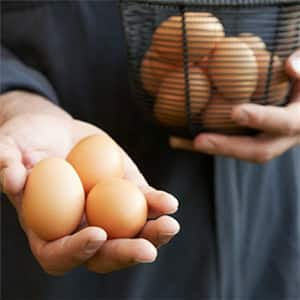 Several years ago, Ben & Jerry’s decided to switch to using Certified Humane® cage-free eggs in our ice cream. The goal of the Certified Humane® program is to improve the lives of farm animals through rigorous standards and by driving consumer demand for kinder and more responsible farm animal practices. We were convinced by the research that cage-free egg systems, combined with rigorous third-party certification, allow hens more opportunity to engage in normal hen behaviors such as roosting, scratching, and flapping their wings.
Several years ago, Ben & Jerry’s decided to switch to using Certified Humane® cage-free eggs in our ice cream. The goal of the Certified Humane® program is to improve the lives of farm animals through rigorous standards and by driving consumer demand for kinder and more responsible farm animal practices. We were convinced by the research that cage-free egg systems, combined with rigorous third-party certification, allow hens more opportunity to engage in normal hen behaviors such as roosting, scratching, and flapping their wings.
As one of the first companies to commit to Certified Humane® cage-free, we were ahead of the market and had to make the change in stages so the cage-free egg industry could catch up with our demand. We also had logistical challenges of our own to solve. We went ‘free-range’ for our European egg supply starting in 2005; and we started the transition to cage-free in the U.S. in 2007.
GOAL: Source 100% Certified Humane® cage-free eggs in North American and free range eggs in Europe.
PROGRESS: In 2013 98.0% of the eggs we used were from Certified Humane® cage-free hens. At the end of 2014, 97.9% of the eggs used in North America were from Certified Humane® cage-free hens. We achieved 100% free range eggs in Europe, for a total of roughly 98.7% globally. One of the ongoing issues to complete this conversion is due to the low volumes of our ice cream bars, which makes it difficult to convert the bars, keeping our conversion under 100%.
SUGARED EGGS
Beyond the cage-free egg transition, we are also working to make sure that the sugared eggs we buy are sweetened with Fairtrade-certified sugar.
GOAL: Our revised goal is to source fully Fairtrade-certified sugared eggs by end of 2014.
PROGRESS: In 2014, 97.9% of sugared eggs in North American were Fairtrade, up from 56% in 2013. In Europe, we achieved our goal in 2012 and 100% of the eggs we use in our ice cream are processed with Fairtrade-certified sugar. On a global basis, therefore, we estimate that in 2014 nearly 98.7% of sugared eggs used in our ice cream were Fairtrade-certified, up from 73% in 2013.
MINORITY SOURCING
Minority Sourcing
In 1998 we instituted a minority supplier program for our non-ingredient purchases. Given that the Company’s ingredient purchases are largely commodities, where we buy from a handful of suppliers, we felt there was more opportunity for diversity in our non-ingredient purchases. We had long recognized the opportunity to include a diverse supplier base in our supply chain purchases. This would include businesses operated by women and minorities. Ben & Jerry's recognized the definition of a diverse supplier as defined by the National Minority Supplier Development Council. Our objective in establishing a supplier diversity program was to seek out and encourage spending with minority owned companies.
Regrettably, in 2004, we suspended our formal supplier diversity program due to what was stated at that time as “redirected priorities, staffing changes and cost savings mandates had made it impossible to continue the program.”
In 2014 we made strides to re-establish a means to measure this within our purchasing programs and in 2015 we intend to redefine how a minority sourcing initiative can be meaningfully developed as a part of our values-led sourcing initiatives. Once we complete that, we will develop the metrics to measure our progress and reactivate it in the QoR metrics table for our 2015 annual review.
COMMUNITY INVOLVEMENT & ACTIVISM
Social Mission Activism
Let’s dip into a little Latin, “Qui tacet consentire videtur” (roughly put, “He who is silent consents.”) We’ve always lived under the belief that we should stand for something and not be shy about it. So, we tend not to be silent on issues we care about. That leads us to engage in activist campaigns around important issues that are aligned with our Company values and partnerships with organizations that share our values and view of the world. We’ve never been afraid to speak up for social and economic justice, sustainable food, or peace! Here’s a look at where we were active in 2014.
Supporting Young Social Entrepreneurs
JOIN OUR CORE
In partnership with our friends at Ashoka we launched the 2014 Join Our Core competition to find and help support the best young social entrepreneurs across Europe and Asia. The competition is the perfect way for Ben & Jerry’s to support young entrepreneurs who share our vision of linked prosperity.  This year marks the third anniversary of the European competition and the inaugural year for Singapore and Japan. After the finalists presented their plans to a panel of judges, one winner from each of the 11 countries was chosen. Each winner received a €10,000 cash prize, a business mentoring program from the social enterprise gurus at Ashoka, and a trip to Ben & Jerry’s headquarters in Vermont. The winners will also have their business logos featured on an exclusive Ben & Jerry’s flavor in 2015.
This year marks the third anniversary of the European competition and the inaugural year for Singapore and Japan. After the finalists presented their plans to a panel of judges, one winner from each of the 11 countries was chosen. Each winner received a €10,000 cash prize, a business mentoring program from the social enterprise gurus at Ashoka, and a trip to Ben & Jerry’s headquarters in Vermont. The winners will also have their business logos featured on an exclusive Ben & Jerry’s flavor in 2015.
Overall, Join Our Core was a smashing success, a ton of fun and a perfect way for Ben & Jerry’s to support young entrepreneurs who share our vision of linked prosperity. We can hardly wait to do it again in 2015.
Read more about the Join Our Core finalist on the Join our Core website.
Standing for Marriage Equality
Ben & Jerry’s has a long history of commitment to social justice, including gay rights. This commitment is grounded in our Company’s core values, which include a deep respect for people inside and outside our Company and an unshakable belief that all people deserve full and equal civil rights. We’ve been providing benefits to same sex couples since 1989 and since then have been active in supporting marriage equality laws. Until same sex couples are afforded the same rights as heterosexual couples around the globe, we will 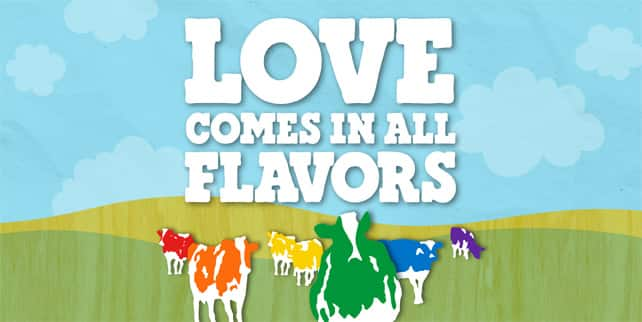 continue to work with relevant nonprofit partners to build public support for marriage equality, add our voice to the public discourse around marriage equality and celebrate the expansion of marriage equality to new states and countries.
continue to work with relevant nonprofit partners to build public support for marriage equality, add our voice to the public discourse around marriage equality and celebrate the expansion of marriage equality to new states and countries.
In 2014 we took action and signed onto an “Employers’ Amicus Brief” asking the Supreme Court to review the circuit court rulings, and to make a ruling prohibiting state governments from acting to hinder businesses from treating all of its legally married employees in the same way.
By signing on to the brief, Ben & Jerry’s (and the 29 other corporations who signed-up), are on record saying that in addition to marriage equality being an issue of civil rights, letting states take the lead, creates a burden for businesses. Leaving the issue to the states complicates the running of our businesses, creating a confusing administrative nightmare for companies—from a tax point of view, and from a benefits point of view.
Marriage Equality Activism Around the Globe
Ben & Jerry’s Appley Ever After campaign in the UK came to a victorious end in 2014, when, at midnight on March 29, 2014, same sex couples could legally marry in England and Wales. To celebrate this historic day for equality in the UK, Ben & Jerry’s held a celebratory party with our partners, Stonewall, at London nightspot Heaven. Following this event, Ben & Jerry’s went to scoop the last ever tubs of Appley Ever After at one of the first same sex weddings in the UK. Nick and Simon tied the knot in Kent, UK, so the Ben & Jerry’s team took their VW camper van down to scoop to their wedding guests. It was a fitting end to a campaign that helped bring social justice to the UK.
Our Marriage Equality advocacy in Australia made waves in 2013 but dialed things back in 2014 to prepare for key advocacy moments in 2015.
In 2014 Ben & Jerry’s participated for the first time in the Tokyo Rainbow Pride parade.
Learn more about Ben & Jerry’s position on marriage equality and gay and lesbian rights.
Bob Marley Tribute & Community Empowerment
In the UK, our Marley tribute campaign is our highlight of 2014. We brought depth and reach to the campaign through our partnership with Marley’s 1Love Foundation and with Partners for Youth Empowerment (PYE), a community empowerment program in Jamaica. We created real fan engagement at the Legend Session in London on October 15 by uniting musicians of all styles, social activists and music fans. Our Marley partnership is not just a one off. We will continue our campaign in 2015 when we work on Community Empowerment projects in Jamaica and in our key cities in Europe (London, Stockholm, Amsterdam and Hamburg).
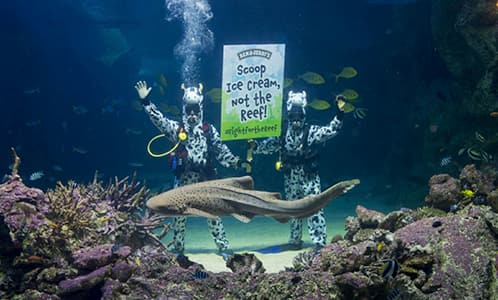 Advocating for the Great Barrier Reef in Australia
Advocating for the Great Barrier Reef in Australia
In Australia, the fight for the Great Barrier Reef was the key campaign in 2014. We achieved a breakthrough, as the multinational consortium responsible for the Abbot Point coal terminal abandoned its plans to dump dredge spoil on the Great Barrier Reef. We will continue our support of the Fight for the Reef Campaign with WWF Australia throughout our Open Air Cinema season, which started on the 28th of September 2014, where we are going to engage fans around the Reef and its protection, promoting our campaign messages to 150K plus Open Air Cinema goers until April 2015.
Public Space in Brazil
We opened our first scoop shop in Brazil in 2014, Sao Paulo, specifically. We launched with all three parts of our Mission in action. On the Social Mission side, we worked with Minha Sampa in 2014, an organization that allows young people to create change in their local city life. Minha Sampa connects directly with young people to help them coordinate movements to create change. They have a history of challenging local governments and political systems to drive collective community change.
Minha Sampa joined us for our launch event. We raised awareness on one of their campaigns getting fans to sign their online petition to the local government to give the public access to a key city street on a Sunday by banning cars. This petition is now sitting with the Sao Paulo municipal government for consideration and review. In late October the team did their first social mission sampling event - the Kombi van giving out over 300 scoops and the team collected over 350 signatures to support the Parque Minhocao organization, which is seeking to create a “highline” type of public space within the city.
Supporting a Fair and Just Political System
Get the Dough Out
Ben & Jerry’s has been advocating for democracy and justice since the first cone was scooped in 1978. Over the years we have taken an activist stand and provided support to citizens’ efforts to rein in corporate money in politics, we pay a livable wage to our employees, we directly support family farms and we are working to source Fairtrade-certified ingredients for all our products.
 Inspired by the Occupy movement, in 2012 we launched the Get the Dough Out of Politics campaign to increase awareness of the need for fundamental reforms that will reduce or eliminate undue corporate influence in the democratic process and to encourage citizens to take a stand.
Inspired by the Occupy movement, in 2012 we launched the Get the Dough Out of Politics campaign to increase awareness of the need for fundamental reforms that will reduce or eliminate undue corporate influence in the democratic process and to encourage citizens to take a stand.
A few months before the 2014 election, as Congress prepared to vote on creating a 28th Amendment to the Constitution to get big money out of politics by overturning Citizens United, we got active. With our partners at Public Citizen and Free Speech for People, we launched a campaign to educate and inspire citizens to contact their Senators and tell them that it’s time to get the dough out of politics!
Citizens United has yet to be overturned, but we are hopeful, as dozens of grass-roots groups that have been working on this issues are converging into a true movement. Sixteen states, along with some 550 cities and towns, have formally called for a constitutional amendment to overturn Citizens United, and more than 3.5 million Americans have signed their name to petitions to overturn Citizens United.
A 21ST CENTURY DEMOCRACY
We believe in a participatory democracy that puts the voice of the people above the interests of the wealthy; That’s why we did not hesitate to sign on to the Principles for a 21st Century - a guiding document that we believe is a turning point in the push to renew American democracy. It lays out the framework for an open and honest electoral system where everyone participates, and everyone’s voice is heard.
Democracy belongs to the people and a vital and fair democracy is the fastest way to produce laws that lead to social justice, economic prosperity and environmental health. We remain firm in our position to keep corporate money out of our elections and are proud to support those leading the effort.
Scoop Shop Social Action
Ben & Jerry’s began as a single ice cream scoop shop in 1978, and though our business has expanded wildly since then, our roots are still firmly planted as a scoop shop company. Most are owned and operated by independent franchisees, although Ben & Jerry’s also operates three company-owned stores. A handful of our scoop shops are what we call a PartnerShop®.
In many ways, our scoop shops are the centerpiece of our Social Mission, because they are the places where we directly touch local communities. Every year, they contribute hundreds of thousands of dollars in time, ice cream, and sponsorships in support of community projects of all sizes and shapes, from Green-Up Days to Food Drives to Hunger Walks.
2015 Global Franchisee Meeting
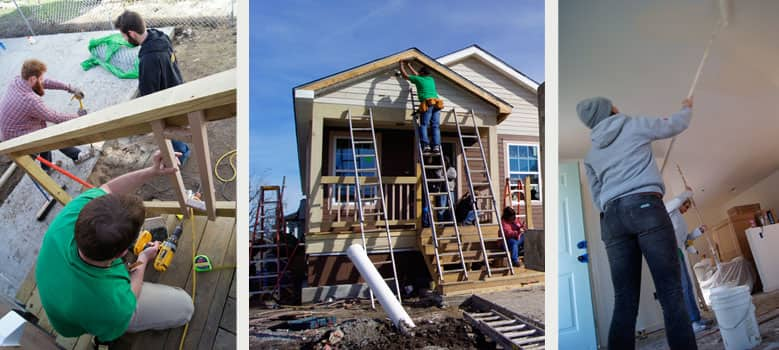 Once a year, the franchise community gets together for our largest company supported community service project in conjunction with their franchise community meeting. In 2014, in conjunction with the annual franchisee meeting in New Orleans, more than 200 franchisees, managers, staff and friends rolled up their sleeves for a Habitat for Humanity project in the New Orleans East neighborhood.
Once a year, the franchise community gets together for our largest company supported community service project in conjunction with their franchise community meeting. In 2014, in conjunction with the annual franchisee meeting in New Orleans, more than 200 franchisees, managers, staff and friends rolled up their sleeves for a Habitat for Humanity project in the New Orleans East neighborhood.
Working from the ground up —literally, digging trenches and installing cinderblock stilts and foundation flooring, all the way up to installing the finishing touches on the interior flooring and exterior trim work— we had over 225 volunteers spread over seven teams working on the numerous phases of home building.
Read more about our community service work in New Orleans.
Measuring Social Impact Among Franchisees
Every year we strive to find more effective methodologies to measure the Social Mission engagement of our franchisees, as well as the support we provide for their Social Mission activities. Currently, we take into consideration a variety of scores relating to financial performance; the franchisor-franchisee relationship; and Social Mission activities. Most of this data is proprietary or, because it relates to our business relationships with franchisees, is too sensitive to report publicly. Additionally, we are only able to measure Social Mission engagement in our U.S. scoop shops.
Here’s what we can tell you. In general terms, during 2014 we experienced improvements in each of the 4 areas of scoop shop financial performance, relative to 2013.
With Respect to the 2014 franchisor-franchisee relationship, we saw improvements in 2 of the 3 areas of measure, relative to 2013.
Of course, we ended the work day with an ice cream fiesta!
In the 6 areas in which we track Social Mission engagement, here’s where we finished vs. 2013:
- 3 out of 6 measures improved
- 2 out of 6 measures declined
- 1 area remained flat
Scoop Shop Community Action Program (CAP)
The Scoop Shop Community Action Program (C.A.P. Grants), piloted in 2012, supports franchisees’ efforts to get involved in their communities and give back. This year, we worked closely with 33 scoop shops in the U.S. to help them mobilize their CAT’s (Community Action Teams) and provided financial support to help their community-oriented projects happen. We are encouraged by the 33 shops (13 more shops than our 2013 count!) that participated in the program.
Employee Community Action Team (CAT) Projects
The Ben & Jerry’s Foundation funds the Vermont Community Action Team (CAT) grant program, which allows employees to support organizations in the places where they live and work. Each site gives away $75,000 and has a CAT that consists of 8-12 members. The CATs meet monthly and make grants between $500 to $2000. The CAT’s focus their decisions based on the following points: underserved populations including seniors, at-risk youth, and low-income people; needs of underserved communities; basic human needs; and organizations that are primarily volunteer-led. The CAT’s reviewed 186 proposals and made grants totaling $225,000 to 163 organizations. Here are a few Community Action Team grants made in 2014:
Central Support Site project: In 2014, the Central Support team traveled to South Hero, Vermont, to complete a day of service at Camp Ta Kum Ta. The Central employees spent the day cleaning cabins, landscaping, picking up the grounds, and moving a storage shed, in preparation of campers.
- For the second year in a row, the Waterbury CAT team issued a $500 grant to the CERV (Community Emergency Relief Volunteers) Summer Lunch Program, which provided meals to children in and around Northfield, Vermont who would otherwise go without during the summer vacation months.
- The Central Support CAT made a grant of $1,500 to Our Community Cares Camp, Inc., a summer food service program and enrichment day camp that serves children from five rural communities in Eastern Chittenden County. The grant was used to purchase farm fresh foods from a variety of local farms, businesses & farmer’s markets. Fresh food is important to the organization’s mission of feeding children and providing a safe and caring place for them within the community.
- In 2014, the St. Albans CAT continued its support of River Arts of Morrisville, Inc., with a $2,000 grant. These funds were used to support the 2014 Summer Youth Programs for children and youth, ages 4-17.
- In addition to individual grants, each year, Ben & Jerry’s employees work together on several large-scale community service projects that the CATs organize - to fix, clean, build, and refresh things that improve the quality of life for our communities:
- St. Albans Site project: Teams from our manufacturing site in St Albans participated in multiple community volunteer projects in 2014. Some of these volunteer activities included: Camp Abanaki, Children’s Fishing Derby, Highgate Arena, Glow in the Dark Run, Green-Up Day, Relay for Life, and the St. Albans Raid Half Marathon.
- Waterbury Site project: In 2014, the Waterbury CAT team gathered together for a day of service at Little River State Park in Waterbury, Vermont. The team spent a mid-September day raking leaves, removing trash & debris, and moving picnic tables to storage.
Nonprofit Partnerships
We are honored to have the opportunity to partner with some truly amazing nonprofit organizations, all around the globe. We support these partners in a variety of ways including product and cash donations, royalties from flavors, volunteer hours, purchasing their products, investing in their enterprises and collaborating to move social issues we care about forward. While we hope their affiliation with us offers our partners some real benefit, our connections to these NGOs keep us true to our core and inspires us every day.
Starting with our perennial and primary partnership with the Ben & Jerry’s Foundation, here are a few of the organizations we partnered with in 2014:
THE BEN & JERRY’S FOUNDATION
Part of Ben & Jerry’s commitment to social and economic justice is our support of the Ben & Jerry’s Foundation, which makes grants to grassroots activists making positive change in their own communities. Through the Foundation, we’re helping immigrant workers, neighborhood groups, farm workers and dozens of other groups around the country to get organized and fight for a fair deal. Grant decisions are driven by a committee of non-management level employees. In 2014, 51 Ben & Jerry’s employees joined a Foundation committee as a grant-maker. In addition 14% of the Company’s employees participated in the Foundation’s Matching Gift Program by making 155 contributions totaling $30,600. Participation in our matching gift program has never been as high as we’d like it to be and seeing the participation rate decrease by 7% from 2013 is clearly a step in the wrong direction.
In 2014, Ben & Jerry’s contributed $2,613,582 to The Foundation, an increase from $2,530,080 in the previous year. To learn more about The Foundation and the organizations they support, visit the website or view the 2014 Annual Report.
ASHOKA
In 2014 we continued our partnership with the social entrepreneur gurus at Ashoka - our lead partner for Join Our Core. With help from Ashoka and our other collaborating partners, Join Our Core, a competition to find the most innovative young social entrepreneurs across Europe and Asia, was a huge success. We can't wait to do it all over again in 2015. Click here to learn more about Ashoka.
MISSION AUSTRALIA
Mission Australia works with our team in Australia to help provide jobs and job training in our scoop shops, for disadvantaged young people. During 2014, our Bondi store supported a fun run, while our Chatswood store scooped ice cream at a local event.
Learn more about Mission Australia.
DREAM
DREAM, is a nonprofit mentoring organization that matches college mentors with young people growing up in subsidized housing projects. Within our South Burlington office, Ben & Jerry’s donates office space to DREAM. DREAM staff have access to shared resources in the building, including the employee kitchen, meeting rooms, and photocopiers. We’re glad to be able to support its innovative and important work.
BICEP
We continued to support and be an active member of Business for Innovative Climate and Energy Policy (BICEP) an advocacy coalition of businesses committed to working with policy makers to pass meaningful energy and climate legislation.
THE CLIMATE REALITY PROJECT
The Climate Reality Project, founded by Vice President Al Gore is a diverse group of more than a million individuals, business leaders, scientists, cultural leaders, marketers and more who are committed to creating a more healthy, sustainable, and prosperous future by shifting from fossil fuels to clean, renewable energies like solar and wind. We’ve learned so much from our friends at the Climate Reality Project during our first year collaborating and we look forward to continuing our work with this seasoned and effective advocacy organization into 2015.
PARTNERSHOP PARTNERSHIPS
PartnerShops are Ben & Jerry’s Scoop Shops that are independently owned and operated by community-based nonprofit organizations. Ben & Jerry’s waives the standard franchise fees and provides additional support to help nonprofits operate strong businesses. PartnerShops offer job and entrepreneurial training to youth and young adults that may face barriers to employment. Ultimately, they help people build better lives.
Learn more about the nonprofits that operate our PartnerShops.
Royalties Paid to Nonprofits
Every day around the globe, in scoop shops, shopping centers, and grocery stores, a percentage of sales of certain Ben & Jerry’s products are directed to nonprofit charitable organizations, including Fairtrade organizations. These products include:
- All Fairtrade-certified flavors sold in Europe and Fairtrade-certified flavors sold in the U.S. contribute licensing fees that support the work of Fairtrade labeling organizations and around the world – in addition to Fairtrade premiums paid to farmers or farmer cooperatives for the ingredients they grow for us.
- Bonnaroo Buzz – Royalties are paid to the Bonnaroo Works Fund to support national and regional organizations with a mission of making communities healthy by investing in the arts, education and the environment.
- Liz Lemon Greek Yogurt - Royalties are paid to Jumpstart, a non-profit that supports early education in low-income neighborhoods.
- Phish Food® (global) – Some of the royalties from this flavor are paid to the Waterwheel Foundation’s Lake Champlain Initiative, which protects the health of this beautiful lake on Vermont’s western border, and its surrounding watershed.
- Stephen Colbert’s Americone Dream™ (US) – Royalties are paid to the Stephen Colbert Americone Dream Fund to benefit children, veterans, and the environment.
- Late Night Snack - We continued to contribute proceeds from our flavor, “Late Night Snack” to support Fair Trade Universities in the US. (Although, sadly, due to Jimmy Fallon’s new job as the Tonight Show’s host, “Late Night Snack” is discontinued, which means this royalty will sunset as this flavor sells out.)
- Willie Nelson’s Country Peach Cobbler™ (US) – Royalties are paid to Farm Aid and its ongoing mission to support family-farm centered agriculture in America and to keep family farmers on their land.
- Scotchy Scotch Scotch (North American) – Royalties are paid to Cancer for College an organization that grants college scholarships to cancer survivors.
- Satisfy My Bowl (Europe) – Royalties are paid to the 1Love Foundation. The Bob Marley family foundation to support youth empowerment programs.
B Corp Certification
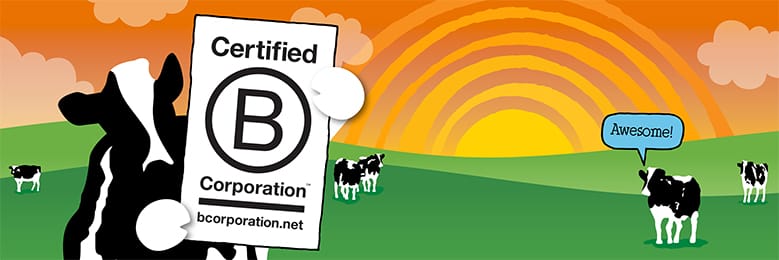 Ben & Jerry’s has always believed in linked prosperity - that all stakeholders connected to the business should prosper as it prospers, from those who produce the ingredients, to employees who make the product, to the communities in which the Company operates.
Ben & Jerry’s has always believed in linked prosperity - that all stakeholders connected to the business should prosper as it prospers, from those who produce the ingredients, to employees who make the product, to the communities in which the Company operates.
In October 2012, a quarter-century after pioneering the socially responsible business movement, Ben & Jerry’s became the first wholly-owned subsidiary in the world, with full support from our parent company, Unilever, to gain B Corp Certification. We completed a reassessment in 2014 and raised our score from 89 to 101 points.
B Corps are a new type of corporation that uses the power of business to solve social and environmental problems. B Corps must satisfy a rigorous assessment by the non-profit B Lab that covers: corporate governance, worker benefits, community engagement and environmental performance.
We think B Corp Certification is the next chapter for socially responsible businesses and we are proud to be an active player in the B Corp movement.
Learn more about Ben & Jerry’s joining the B Corp movement.
Learn more about B Corporations and view Ben & Jerry’s Impact Assessment at: www.bcorporation.net/community/ben-jerrys
LIVABLE WAGE & MORE
Employee Wellbeing & Culture
LIVABLE WAGE
Ben & Jerry’s is committed to paying all of its workers a livable wage, and our livable Wage Policy covers all full and part-time employees in our Vermont manufacturing plants and in all of our company-owned scoop shops. In 1995 we established a method for calculating a livable wage benchmark for Vermont. We defined it as the starting wage for a single person that will sustain a reasonable quality of life to include expenditures for housing, utilities, out-of-pocket health care, transportation, food, recreation, savings, taxes, and miscellaneous expenses. Since then, we’ve adjusted this livable wage annually to ensure the relative value is sustained in today’s marketplace.
Our 2014 hourly wage $16.29 translates to $33,883 per year. For comparison, at year-end 2014, the minimum wage in Vermont was $8.73/hr ($18,158/yr) and the national minimum wage was $7.25/hr ($15,080/yr). On January 1, 2015, the Vermont minimum wage was scheduled to increase to $9.15/hr ($19,032/yr). Meanwhile, the national minimum wage has stayed the same since 2009. Over the years, our minimum wage has continued to increase at a rate faster than the national and Vermont minimum wage.
Globally, we have reviewed how our livable wage stands up for the primary employees who make Ben & Jerry’s at manufacturing sites in Henderson, NV; Sikeston, MO; Simcoe, Ontario; and Hellendoorn, in The Netherlands. We believe that, based upon local standards, our livable wage is met at those sites. Because this is an extensive process to complete globally, we focus yearly reviews on the US.
Tracking Ben & Jerry’s Livable Wage (Vermont)
- 2014 - $16.29
- 2013 - $16.13
- 2012 - $15.97
- 2011 - $15.34
- 2010 - $14.64
121 people report to the Central offices
298 people report to the two manufacturing sites in Vermont (Waterbury and St. Albans)
DIVERSITY
Ben & Jerry’s is an equal opportunity employer that values diversity in our workforce. One element of this commitment is our application of Affirmative Action practices to look for conspicuous imbalances in our workforce and take positive steps to correct them. Affirmative Action plans focus on equality in hiring, training, promoting, and compensating employees.
In 2014, in an effort to achieve a wider pool of candidates, we began working with recruiters and non-profit organizations serving underrepresented populations in Vermont. Our data shows a slow but promising increase in diversity representation, particularly among females- with the factory management team scoring highest in overall diversity. While we are performing better than benchmark when compared to national averages in racial diversity and female representation, we know we still have work to do.
VOLUNTEER BENEFIT
Each year, through a variety of Company sponsored volunteer hours, we encourage our employees to get out into the real world and give back. That can come in the form of 40 paid volunteer hours that many of our employees can use, or group projects that are organized by Ben & Jerry’s worksites or at various Company gatherings throughout the year. Overall, adding up group community projects and individual volunteer time, we estimate that employees logged about 4,613 hours of paid volunteer time globally in 2014, which was up from the 4,492 hours in 2013. But the truth is that we don’t believe we are properly capturing all of the volunteer hours and community projects that Ben & Jerry’s people are logging around the world. So, we know that we need to do a better job of capturing and reporting that.
CLIMATE & ENVIRONMENT
Climate Justice & Environment
When it comes to the issue of climate justice and the environment, we know that our business is at the center of some of the most pressing climate issues of our time. We are a frozen product made from agricultural ingredients. We make it, freeze it and ship it. So, we know we have to work harder to mitigate our impact on the environment.
In 2014 we completed a Life Cycle Analysis (LCA) of our products that helped us lay the groundwork for a comprehensive and bold carbon reduction plan and a 2015 climate justice campaign. The LCA will be expanded in 2015 to get a more accurate picture of our global footprint. One thing that is clear from the LCA work we’ve done so far is that our biggest carbon footprint is in our ingredient supply chain with dairy farming as the single greatest contributor. So, we will focus our reduction efforts there, to start.
Taking our mission, business goals and supply chain challenges into consideration, Ben & Jerry’s approached NativeEnergy, an expert Vermont-based carbon offsetting firm, specifically for a greenhouse gas emissions reduction project on a farm in Vermont, where its two manufacturing facilities are located and their cultural fabric originates.
Outside the company, our global campaign focuses on three priorities:
- Reducing green house gas emissions for our company, which includes reduction targets for our linked prosperity supply chain
- Advocating for policies that fully phase out fossil fuels
- Global activism that helps build a diverse and effective climate movement
Carbon Reduction and Offsets
Continuing what we started the year before, in 2014 we moved away from carbon offsets and towards a process called “carbon insetting” which means we are working on reducing emissions within our supply chain. We know that our ingredients and specifically our dairy farms represent the largest source of greenhouse gas (GHG) emissions and in 2014 we continued to pursue projects such as a manure separator project with Vermont-based NativeEnergy that will reduce methane emissions on Caring Dairy™ farms. The manure separation equipment and a drum composter will process cow manure into a sanitary bedding material in place of increasingly costly sawdust.
The project is designed to:
- reduce greenhouse gas emissions by removing a portion of the manure solids that are traditionally held in the farm’s manure lagoon where they break down and produce methane gas
- decrease potential run-off pollution, primarily phosphorus, by reducing the volume of waste material that needs to be spread on nearby fields
- strengthen the long-term financial sustainability of the farm by reducing costs associated with bedding and hauling and spreading waste material
The project will reduce 10,550 metric tons of CO2 over the first 10 years of the project’s operations.
The investment we made in the project covers all of the emissions from our manufacturing plants and our air travel for 2014.
Part of the plan for climate mitigation in Europe included the installation of a bio-digester and a new heat conversion plant at our manufacturing site in Hellendoorn, the Netherlands. The biodigester turns the factory’s dairy waste into energy. Although we have some kinks to work out to improve its performance, we are decreasing our reliance on natural gas and we are on our way to converting the site to be CO2 neutral.
Manufacturing
Ben & Jerry’s ice cream for the North American market is made in our manufacturing plants in Waterbury and St. Albans, Vermont and in a Unilever facility in Henderson, Nevada. We make Ben & Jerry’s ice cream for the European market in a Unilever facility in Hellendoorn, The Netherlands and for the Canadian market in a Unilever facility in Simcoe, Ontario. We make ice cream for Asian markets in our Vermont manufacturing plants. Our frozen novelties are manufactured at a Unilever facility in Sikeston, Missouri. We recognize the impact that our manufacturing process has on the environment and work at all levels to reduce our environmental impact.
We are measuring Ben & Jerry’s environmental impact for the purposes of our QoR metric by looking at four performance parameters at every plant that makes Ben & Jerry’s ice cream products - water, solid waste, energy and CO2 emissions. Using a formula that weights each plant’s performance by the volume of Ben & Jerry’s products it produces, we calculated the following outcomes in 2013: (weighted global results - normalized performance – per gallon of product).
2014 Environmental Numbers
- Water Use: 5% worse than 2013 (cubic meters per unit of production)
- Solid Waste: 8.2% better than 2013 (kg per unit of production)
- Energy Use: 1.1% worse than 2013 (gigajoules per unit of production)
- CO2 Emissions: 26.9 % worse than 2013 (kg per unit of production)
Ben & Jerry’s plant in Europe, based in the Netherlands, saw its biodigester “AKA the Chunkinator”, become fully operational in 2014. This great piece of sustainability can convert any ice cream waste from the plant, 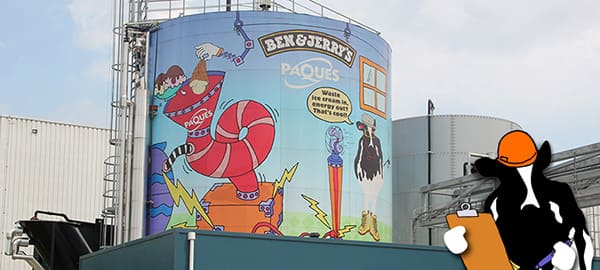 as well as all the cleaning water, into energy with the help of millions of tiny bacteria that work to break down the energy in the waste. The Chunkinator, as it is lovingly known to the team at Hellendoorn, has the ability to produce all the heat requirements for the plant; roughly 20% of the energy needs. All from chunks of cookie dough! The project is part of a wider scheme in Hellendoorn, which employs a number of sustainability initiatives that seek to reduce and reuse the energy that the plant uses in order to make great tasting ice cream in the nicest possible way.
as well as all the cleaning water, into energy with the help of millions of tiny bacteria that work to break down the energy in the waste. The Chunkinator, as it is lovingly known to the team at Hellendoorn, has the ability to produce all the heat requirements for the plant; roughly 20% of the energy needs. All from chunks of cookie dough! The project is part of a wider scheme in Hellendoorn, which employs a number of sustainability initiatives that seek to reduce and reuse the energy that the plant uses in order to make great tasting ice cream in the nicest possible way.
Packaging
For years, Ben & Jerry’s has been working to reduce the negative environmental impacts of our packaging materials. It has always been a challenge, given that our packaging must meet strict requirements for food packaging and also has to stand up to temperatures of 20 degrees below zero (F).
Pint Cartons and Novelty Boxes
In 2014, all of the paperboard used in our pint-sized cartons, mini-cup containers and novelty boxes (pretty much most of our packaged goods) is Forest Stewardship Council (FSC) certified, globally. We began converting our quart containers in 2014 to FSC. We plan to complete that conversion in 2015. The FSC certification means that the paperboard comes from forests that are managed for the protection of wildlife habitat, maintenance of biodiversity, avoidance of genetically modified tree species, and protection of traditional and civil rights, among other Rainforest Alliance criteria for healthy forests.
While our pint containers are not allowed to contain post-consumer recycled material because of food contact regulations, we are using 100% recycled paperboard in the boxes that we use for Ben & Jerry’s ice cream bars in the U.S.
Scoop Shops
On an ongoing basis, we are working to improve the materials used in Ben & Jerry’s scoop shops, such as bowls, spoons, drink cups, napkins. For example, in the U.S., we have used unbleached paper in our napkins for many years and our drink cups, while made of plastic, are recyclable and have been light-weighted to use as little material as possible.
Corporate Office Materials
In our corporate office, we have made significant strides in using environmentally friendly materials, including 100% post-consumer recycled and process chlorine-free paper; compostable dinnerware, green cleaning solutions, low-VOC paints, and flooring that is recyclable.
Note: We have not yet developed metrics that track our progress towards improving the environmental attributes of our secondary packaging, scoop shop packaging or our office materials. We will keep working on it!
Supporting Stronger Climate Policy
At Ben & Jerry’s, we believe the science of global warming is settled. The question now is, “What are we doing about it?” While we are investing in making our operations and supply chain more efficient and reducing our carbon footprint, we know we are just one small company. What the planet really needs is a universal climate change agreement and we need it ASAP. Now more than ever, it's important that policy makers at all levels, around the globe understand the urgency and the impact of climate change and we think it’s our job to urge them to take action. We’re compelled to act on this issue on behalf of the worlds' most vulnerable citizens who will pay the highest price for a problem they didn’t create. It’s about, among others, our smallholder Fairtrade suppliers in the global south that risk having their livelihood wiped out by a warming world and changing weather patterns.
Here are some highlights of our advocacy work and activism in 2014.
- In September 2014 Ben & Jerry’s folks in cities around the globe (London, New York and Victoria), turned out to participate in the People’s Climate March, one of the largest climate rallies in history. Activists, non-profits, citizens and businesses joined together to urge policymakers to support a legally binding universal climate change agreement that may change our climate future and save our planet.
- In July, in partnership with The Climate Reality Project, our scoop trucks hit the streets in Atlanta, Denver, Pittsburgh and Washington D.C. as part of the I’m Too Hot campaign. Our mission was to draw attention to the EPA’s Clean Power Plan and to let the EPA know that we support their efforts to reduce harmful carbon pollution and that we want national standards to limit the amount of carbon pollution existing power plants can produce.
- We continued to support Business for Innovative Climate and Energy Policy (BICEP) an advocacy coalition of businesses committed to working with policy makers to pass meaningful energy and climate legislation. We are proud to stand with 233 other major US companies, including our parent company Unilever, to support the EPA’s proposed Carbon Pollution Standards, one of the most significant pieces of climate change policy we’ve seen in the US.
- As a member of the coalition, in 2014, we made several trips to Capitol Hill to persuade lawmakers to act. We focused our efforts on several campaigns encouraging Congressional leaders to make legislative decisions supportive of clean energy policies and to focus on the vital task of passing comprehensive energy and climate legislation. Into 2015, we will continue to keep the pressure on policy makers to turn the draft standards into laws that will reduce emissions and embrace a clean and green energy future. Our goal is for international leaders to work towards 100% Clean Energy by 2050.
To keep the rise of the global average temperature below 2º C, Ben & Jerry’s supports the following policies:
- Ensure that 2/3 of all currently commercially viable fossil fuel reserves remain in the ground
- Completely phase out all fossil fuel emissions as soon as possible, but no later than 2050.
- Make no new investments in fossil fuel infrastructure
- Engage all countries in phasing out fossil fuel emissions, with actions varying depending on countries’ common but differentiated responsibilities and respective capabilities.
- Transition the global economy to 100% renewable energy while ensuring sustainable energy access for all by 2050.
- Put a science-based price on carbon pollution that limits warming to 2º C.
- Create a global framework in which developed economies help fund the shift towards low-emission and climate-resilient sustainable development in developing countries and the global south.
Green Teams
Historically, each of our three Vermont-based Company sites has had a Green Team, comprised of employees interested in environmental issues. These employee-led teams come up with projects, activities, and events that highlight relevant environmental issues within the Company and beyond.
In our St. Albans and Waterbury manufacturing sites, employees continued with many of the same wonderful internal and external activities, established by the Ben & Jerry’s Green Teams in previous years. Some of these 2014 activities included:
- Employees from both sites participated in Vermont Green-Up Day
- In celebration of Arbor Day, Blue Spruce trees were given to all employees.
- The lunchroom food waste from both sites was turned into compost and each site received 20 yards of compost, which employees were given for their home gardens.
- Local organic vegetable seeds were given to all employees to promote local food and “grow a row” for a neighbor.
- St. Albans continued with the onsite Community garden. 100% of the garden harvest was given to the local food shelter.
- Both sites continue to be zero landfill.
In our South Burlington office, a number of employees stepped up to the challenge of resurrecting the Central Support Green Team. In late 2014, the newly re-formed Central Green Team held its first event with a special screening of the film DamNation, and invited a guest speaker to provide employees with some Vermont context for the issues raised in the film.
Review Report of Independent Accountants
Independent Auditor's Report
For our 2014 report, we engaged Moss Adams LLP, an independent accounting firm, to review specific Quality of Results indicators that Ben & Jerry’s set as priorities for the year.

